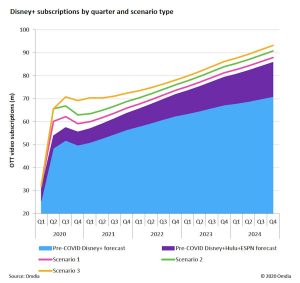
After more than 35 years of operation, TBI is closing its doors and our website will no longer be updated daily. Thank you for all of your support.
TBI Tech & Analysis: Where next for Netflix & Disney+?
Netflix and Disney+ are among the few services to have seen an upside to lockdown but where next for these two SVOD behemoths? Sarah Henschel and Max Signorelli, analysts at TBI sibling Omdia, explore how the two streamers might fare against three different scenarios.
The implications of the Covid-19 virus are constantly developing, so Omdia has gauged its impact according to three distinct scenarios. We assume that at the end of each these scenarios, societies will return to pre-Coronavirus consumption habits.
Scenario one: The virus lasts from Q1 through Q2. Impacts and closures are staggered with events starting in APAC and moving to western markets in the latter half of Q1.
Scenario two: The virus keeps consumers home-bound for six months relative to regional outbreak start (Q1 through Q3). Long-term, global supply chains start to be increasingly affected by lockdown measures.
Scenario 3: The virus keeps consumers socially distanced for 12 months, as a result of a second wave of infections or otherwise (Q1 2020 to Q1 2021). Restrictions in certain areas may relax throughout the year, but people will be encouraged to refrain from international travel, gatherings and large events.
Netflix
• Netflix has a lot to gain in the short term as consumers use their additional free time to watch video content at home. Growing user engagement and service uptake, as well as reduced user churn, will quickly translate to revenue for Netflix in most countries as the company has cut back on free trials.
 • In the longer term however, Netflix will suffer from disrupted content creation schedule in the same way as other large media producers. The company has already cancelled numerous productions across domestic and international markets and this will continue depending on how long the pandemic lasts.
• In the longer term however, Netflix will suffer from disrupted content creation schedule in the same way as other large media producers. The company has already cancelled numerous productions across domestic and international markets and this will continue depending on how long the pandemic lasts.
• Netflix is more reliant on its original programming than ever, especially as new direct to consumer subscription services are launching around the world that threaten to take away the significant market share Netflix has held for so long. Production closures are likely to impact subscriber growth towards the end of 2020 or beginning of 2021, dampening the short term gains brought by quarantine.
• In response to Covid-19 shutting down content production globally, Netflix has created a $150m relief fund for out of work cast and production crews to support them while they shelter at home. This will allow them to remain working on their respective productions and return to work more efficiently at the end of the pandemic.
*Omdia assumes that a proportion of new subscribers will continue subscriptions after Covid-19. Proportions are equal in all scenarios causing parallel lift by 2024.
Scenario analysis:
S1: 2020 subscribers up 18% YoY to 197.5m
S2: 2020 subscribers up 26% YoY to 210.5m
S3: 2020 subscribers up 39% YoY to 231.8m
Disney+
• Toward the end of Q1 2020, Disney+ launched in nine new European markets amidst region-wide lockdowns, with its French launch delayed by two weeks following government concern regarding Disney’s impact on infrastructure. In major European markets, Disney+ launched with several partnerships with local operators, granting it a significant European user base.
 • The Indian launch of Disney+ on 29 March was postponed to 4 April due to the delay in the Indian Premier League cricket tournament. Disney+ was due to launch alongside the tournament as part of its integration into Hotstar, India’s top paid OTT service.
• The Indian launch of Disney+ on 29 March was postponed to 4 April due to the delay in the Indian Premier League cricket tournament. Disney+ was due to launch alongside the tournament as part of its integration into Hotstar, India’s top paid OTT service.
• Like all others, Disney will face delays in production of content but as a brand new OTT subscription service, original content bolsters Disney’s service and could impact growth. However, unlike other D2Cs Disney+ is insulated by strong a family catalog.
• Disney+ is relatively cheap across all of its current markets given the value its content portfolio has to brand specific content fans as well as families. Thus, where consumers are likely to increase their content consumption, Disney+ may be one of the first new subscriptions added by consumers. Omdia was originally expecting increased churn for Mandalorian-centric users in Q1 but these are more likely to now stay into 2020.
* Omdia assumes that a proportion of new subscribers will continue subscriptions after Covid-19. Proportions are equal in all scenarios causing parallel lift by 2024.
Scenario analysis:
S1: 2020 subscribers up 123% YoY to 59.1 m.
S2: 2020 subscribers up 137% YoY to 62.9 m.
S3: 2020 subscribers up 161% to YoY 69.2 m.
Senior analyst Sarah Henschel and Max Signorelli, research analyst, work for Omdia’s Media & Entertainment division. The findings above are from their April report, COVID-19 Impacts on Media and Home Entertainment, Streaming, Digital, and Physical, which provides in-depth analysis of the impact of Coronavirus and how it could affect the entire media landscape, including streamers such as Amazon and Hulu, as well as sector including SVOD, AVOD and TVOD.





